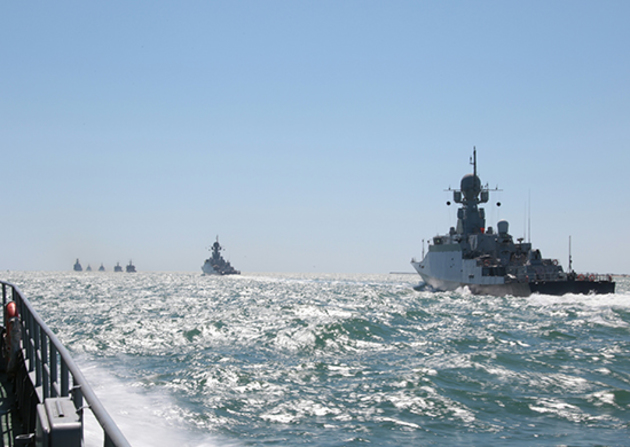Over the past years, Russian diplomats have repeatedly expressed their hope that Tehran will ratify the Convention on the Legal Status of the Caspian Sea signed on August 12, 2018, in Aktau following the results of the 5th Caspian Summit. The document will enter into force after ratification by all signatories - Russia, Azerbaijan, Iran, Kazakhstan and Turkmenistan. So far, everyone except Iran signed the Convention.
According to the document, the activities of the parties in the Caspian Sea should be carried out on the basis of almost two dozen principles, some of which provide for ensuring a stable arms balance of the parties. Some of them are:
- developing military capabilities within the limits of reasonable sufficiency with due regard to the interests of all the Parties and without prejudice to the security of each other
- compliance with the agreed confidence-building measures in the military field in the spirit of predictability and transparency;
- non-presence in the Caspian Sea of armed forces not belonging to the Parties;
- non-provision by a Party of its territory to other States to commit aggression and undertake other military actions against any Party.
Business Insider writes about the naval capabilities of littoral states.
Russia has continued to develop its Caspian flotilla. In October 2015, it demonstrated a significant new capability when some of its ships launched 26 Kalibr cruise missiles at 11 targets in Syria — a distance of about 1,000 miles. They launched even more missiles a month later.
Other Caspian Sea states have largely operated in the shadow of Russia's Caspian Flotilla, but in recent years they have begun to build up their navies to more modern standards.
Azerbaijan, with revenues from its own large oil reserves, has grown its navy and coast guard fleets to a combined force of over 30 ships. Most of them are patrol vessels, but some are relatively modern and advanced ships built by Israeli and Turkish firms.
Turkmenistan has also taken advantage of its commercial and cultural ties to Turkey and purchased a number of Turkish-made vessels. It has 10 Serhet-class patrol boats (based on the Turkish Tuzla-class) and commissioned its first Turkmen-class corvette in August.
Iran has historically had a limited presence in the Caspian. The waters it controls are among the deepest, averaging 3,360 feet, which makes offshore oil drilling difficult. Moreover, Iran's navy has mostly focused on the Persian Gulf. But Iran is also building up its Caspian fleet. In 2003, it completed its first modern Caspian vessel, the IRIS Paykan, a Sina-class fast-attack craft. In 2015, it commissioned the IRIS Damavand, the second frigate of the Mowj-class — Iran's most modern warships. IRIS Damavand sank after an accident in 2018 and is being repaired, but Iran has continued its activity in the Caspian, including regular drills and exercises.
Kazakhstan, which inherited no naval vessels from the Soviet Union, has built a navy with about a dozen ships, including a domestically produced class of missile boats. Kazakhstan also conducts drills and exercises in its waters.
While there is no doubt that other Caspian Sea navies are stronger than they were 30 years ago, Russia's Caspian Flotilla remains the dominant naval force there. Most of Azerbaijan's, Iran's, Kazakhstan's, and Turkmenistan's naval ships are small vessels such as patrol boats, missile boats, or fast-attack craft. The Caspian Flotilla has many similar vessels, but it also has more large warships than anyone else, chief among them the two Gepard-class frigates and six Buyan-class corvettes. Those ships are smaller than the destroyers and cruisers of the Russian navy's other fleets, but, as demonstrated by the 2015 Syria strikes, they carry similar armaments, which are far more capable than the weaponry of neighboring navies.
"The Russians equip these small ships with long-range land-attack and anti-ship missile systems, and they really punch above their weight and size," Jeffrey Edmonds, a research scientist and Russia expert at the CNA think tank, told Insider. Moreover, the Caspian Flotilla is part of Russia's powerful Southern Military District, one of the largest and most important military forces in the Russian military. As such, the Caspian Flotilla's combat power has to be evaluated alongside other assets in the district, such as aircraft and coastal defenses.
"You shouldn't view the Russian Navy broadly or something like Caspian Fleet separate from the rest of the Russian military," Edmonds said. "If there was a conflict in the Caspian Sea, you would have the full might of the Russian military in the region." Additionally, the Caspian Flotilla could be reinforced by ships from Russia's Black Sea Fleet via the Volga-Don Canal, or even by the Baltic Fleet through the much longer Volga-Baltic Waterway if need be. "The Russian military looks at the total correlation of forces." Edmonds said. "They'll calibrate their military capabilities in the region to match or overmatch any potential competitors."
Naval activity in the Caspian will likely increase as new oil fields are discovered and the region's navies grow. Russia's dominance is assured for now, but with more players, it may one day have to compete, Business Insider writes.






